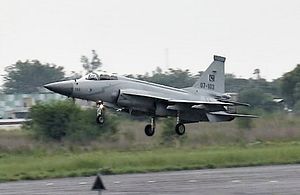A few curated defense and security links:
A Defense News piece shows that Pakistan’s JF-17 Thunder multi-role fighter project is continuing development, despite speculation. According to the chief project director of the JF-17 program, everything is “as per schedule and there are no delays.” Pakistan’s current fleet has logged over 10,000 hours and flown over 13,500 sorties, according to the report. The project seems to mostly be focused on improving the aircraft’s avionics. While most of the JF-17 project is financed by the government-run Pakistan Aeronautical Complex, the report also highlights increasing private investment in the project. The piece additionally goes into other incremental upgrades to the JF-17, from radar to smart missiles, in some detail.
Another Defense News report takes a look at the domestic debate in India on allowing additional foreign direct investment in defense deals. Currently, Indian regulations allow no more than 26 percent of FDI in defense deals. According to the report, “if the level went up to 100 percent, as some industry officials want, it would allow overseas firms to set up fully owned subsidiaries in India.” The Federation of Indian Chambers of Commerce and Industry (FICCI) is lobbying for the FDI limit to be set at 100 percent “only on exceptional basis and would want the ownership to be in the hands of the Indian partners only.”
Over at The National Interest, Flashpoints blogger Harry Kazianis takes a crack at answering what the United States would realistically do should China and Japan go to war. The piece runs through a potential scenario where China and Japan go to war, mandating a response from Washington. Harry sees little possibility that the United States will be able to fully commit to an Asian war “absent the loss of American lives or an outright invasion of a treaty ally.”
A report in Japan’s Asahi Shimbun catalogues the renewed interest among Japanese defense contractors in overseas market after Japan eased its self-imposed ban on weapons exports. The ban, which was implemented in 1967, was effectively lifted when Japan decided to allow the export of indigenous technology to India (Japan is expected to conclude a deal for 15 ShinMaywa US-2 amphibious aircraft with India this year). The Asahi piece discusses the “diplomatic and technological hurdles” Japan needs to surmount before becoming a major arms exporter. In April of this year, Shinzo Abe’s government formally approved weapons exports provided the destination countries meet three conditions.

































